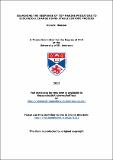Files in this item
Examining the response of top marine predators to ecological change using stable isotope proxies
Item metadata
| dc.contributor.advisor | Boyd, Ian | |
| dc.contributor.advisor | Todd, Christopher David | |
| dc.contributor.author | Hanson, Nora Nell | |
| dc.coverage.spatial | 172 | en_US |
| dc.date.accessioned | 2012-10-24T14:48:13Z | |
| dc.date.available | 2012-10-24T14:48:13Z | |
| dc.date.issued | 2012-11-30 | |
| dc.identifier | uk.bl.ethos.558145 | |
| dc.identifier.uri | https://hdl.handle.net/10023/3221 | |
| dc.description.abstract | Monitoring the response of upper trophic level animals to ecological change is important to understanding the state and stability of ecosystems. Marine predators integrate information over large geographical scales and are relatively long-lived; furthermore, many of these organisms are restricted to terrestrial or freshwater habitats at certain times during their life history and are accessible to researchers. This thesis investigated the response of marine predators to ecological change at a variety of spatial and temporal scales using stable isotope ratio methods with the aims of developing meaningful proxies, or indices, of variability in marine ecosystems. The first study explored the intrinsic (i.e. ontogenetic) and extrinsic (i.e. environmental) factors important to modulating variation in the stable isotope ratios of C and N in tooth dentin of male Antarctic fur seals (Arctocephalus gazella) in the Southern Ocean. In the second study, long-term records of variation in δ¹⁵N and δ¹³C values of Atlantic salmon (Salmo salar) scales and grey seal (Halichoerus grypus) tooth dentin provided evidence for large-scale climate forcing across the eastern North Atlantic. In the following study, a more detailed examination of intra- and inter-individual stable isotope variation in Atlantic salmon within a single year was undertaken in an attempt to better understand recent declines in somatic condition of these fish. The last two studies were concerned with the development of high resolution sampling of fish otoliths using secondary mass spectrometry (SIMS) and the application of this technique to reconstructing the thermal and metabolic histories of individual Atlantic salmon from intra-otolith δ¹³C and δ¹⁸O values. Stable isotope proxies can be used to document shifts in trophic dynamics and animal movement that may be associated with ecological change. Using multiple tissues, elements and species, such studies provide unique monitoring tools at a range of spatial and temporal scales. | en_US |
| dc.language.iso | en | en_US |
| dc.publisher | University of St Andrews | |
| dc.subject.lcc | QH541.5S3H2 | en_US |
| dc.subject.lcsh | Marine ecology | en_US |
| dc.subject.lcsh | Stable isotopes in ecological research | en_US |
| dc.subject.lcsh | Predatory marine animals--Ecology | en_US |
| dc.subject.lcsh | Top predators--Ecology | en_US |
| dc.title | Examining the response of top marine predators to ecological change using stable isotope proxies | en_US |
| dc.type | Thesis | en_US |
| dc.type.qualificationlevel | Doctoral | en_US |
| dc.type.qualificationname | PhD Doctor of Philosophy | en_US |
| dc.publisher.institution | The University of St Andrews | en_US |
This item appears in the following Collection(s)
Items in the St Andrews Research Repository are protected by copyright, with all rights reserved, unless otherwise indicated.

